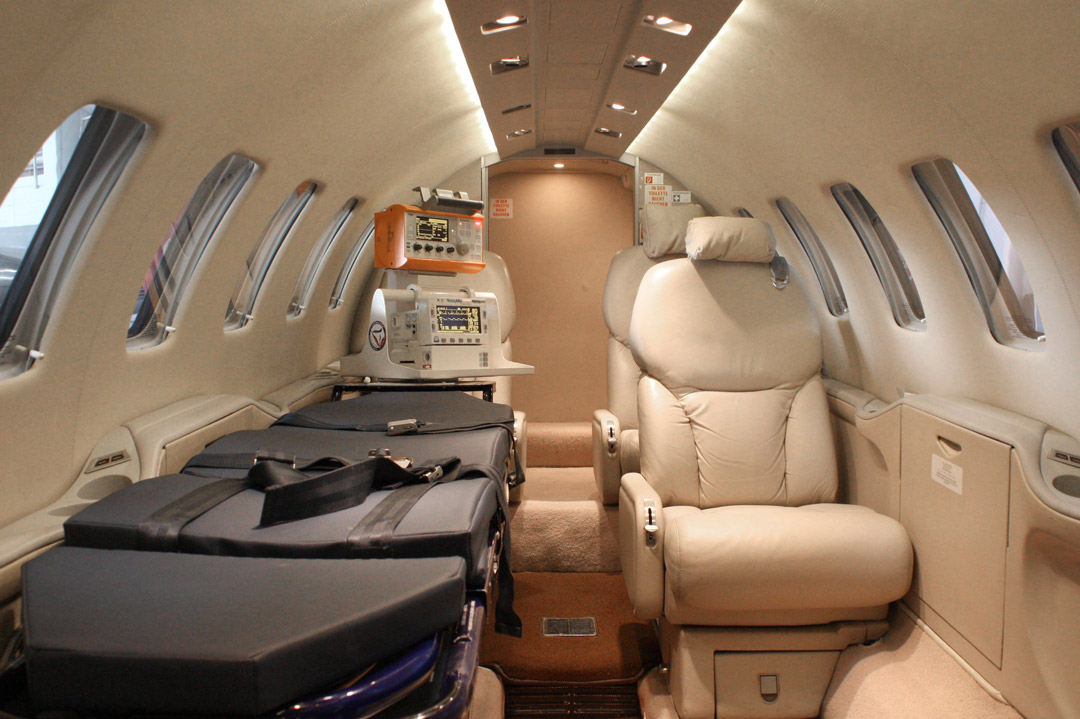Global Air Ambulance specialized in medical transport and medical evacuation by plane, but an air ambulance is any aircraft that has been specially outfitted with medical equipment in order to transport injured or critically ill patients.
These aircraft are designed to accommodate medical equipment and personnel, allowing them to deliver specialized care while in transit.
Helicopters and fixed-wing airplanes are used to provide air ambulance services. However, they're often used for very different circumstances.
Helicopters can fly and land nearly anywhere making them ideal for emergency airlifts. Air ambulance helicopters, also known as medical helicopters or Medevac helicopters, are designed and equipped to provide rapid transport and medical care to critically ill or injured patients in situations where ground transportation is not feasible or would result in unacceptable delays.
What Is An Air Ambulance Used For?
Air ambulances are best for medical flights further than 200 miles. Our staff and equipment ensure safe and comfortable travel for patients who need specialized care. We're equipped to transport patients who range in condition whether cancer treatment, burn care, or strokes.

Most frequently, air ambulance transports patients to their homes, an alternate hospital, or to rehabilitation centers for specific care.
Air ambulance also alleviates the stress of flying on commercial airlines for elderly patients who need more comfortable travel.
What Type of Planes Are Used As Air Ambulances
We use a variety of fixed wing aircraft for air ambulance transfers. They differ in size, fuel capacity, and speed. They also impact the overall cost of trip.
The most commonly plane we use is the LEARJET 35. This is a long distance jet that supports medical stretchers, ICU level equipment, and the ability to seat two aditional family members. Our medical team is equipped to provide a very high level of care during transport.
How Much Does Air Ambulance Cost?
Prices for air ambulance flights range drammatically, but flights within the United States are typically between $20,000 and $40,000 whereas internationaly flights are often over $100,000. Medical flight services are costly procedures, but there are many ways we work to control and reduce the cost.
The location of our aircraft and how quickly you need to move the patient are two of the most important factors in pricing transfer. Locating an aircraft in close proximity to the patient saves time and fuel, which provides significant cost savings. This is how we try to save you money. Air ambulance companies are very competive, so we do our best to offer you the most afforable air ambulance services we can.
If there is flexibility in the dates on transfer we are often able to connect your flight with another nearby. We aim to provide you and your patient the highest level of care for the absolute most affordable price.
How Quickly Do Air Ambulances Fly
The speed at which air ambulances fly can vary depending on several factors, including the type of aircraft, weather conditions, flight regulations, and the specific mission requirements. Generally, air ambulances, including helicopters and fixed-wing aircraft, have different cruising speeds.
Helicopters: Air ambulance helicopters typically have cruising speeds ranging from 120 to 160 miles per hour (193 to 257 kilometers per hour). However, helicopters can also fly at higher speeds if necessary, reaching up to 180 miles per hour (290 kilometers per hour) or more.
Fixed-Wing Aircraft: Fixed-wing air ambulances, which include planes and jets, can have higher cruising speeds compared to helicopters. They usually operate at speeds ranging from 250 to 400 miles per hour (402 to 644 kilometers per hour), depending on the aircraft type.
It's important to note that while these speeds provide a general range, actual flight speeds can vary depending on factors such as airspace restrictions, air traffic congestion, weather conditions, and the specific mission requirements. Additionally, during medical emergencies, the flight crew may prioritize patient stability and safety over maximum speed, ensuring that appropriate medical care is provided during the flight.
What Is Another Name For Air Ambulance?
Air ambulances are also known by various other names depending on the region or context. Some alternative terms used to refer to air ambulances include:
Medevac (Medical evacuation): Medevac helicopters or aircraft are employed to evacuate and transport patients who require urgent medical attention.
EMS helicopters: EMS stands for Emergency Medical Services, and EMS helicopters are dedicated aircraft used for emergency medical transportation.
Life Flight: Life Flight is a common term used to describe air ambulance services, especially in the United States. It emphasizes the critical nature of the service and the aim of providing life-saving transportation.
Air Medics: This term refers to the medical professionals, such as doctors, nurses, and paramedics, who provide care and medical expertise during air ambulance missions.
Air Rescue: Air rescue operations involve the use of aircraft to provide rescue and medical assistance in emergency situations, including medical evacuations.
Aeromedical services: This term encompasses the broader field of medical services provided by aircraft, including air ambulances, medical helicopters, and fixed-wing medical transport.
These are just a few examples of the various names used to describe air ambulance services. The terminology may differ depending on the region, healthcare system, or specific organization providing the service.
Air ambulances are a vital component of the healthcare system, combining swift transportation, advanced medical capabilities, and skilled medical personnel to deliver timely and specialized care to patients in critical conditions. Their ability to provide rapid response and transportation in emergency situations makes them a critical lifeline for those in need.
